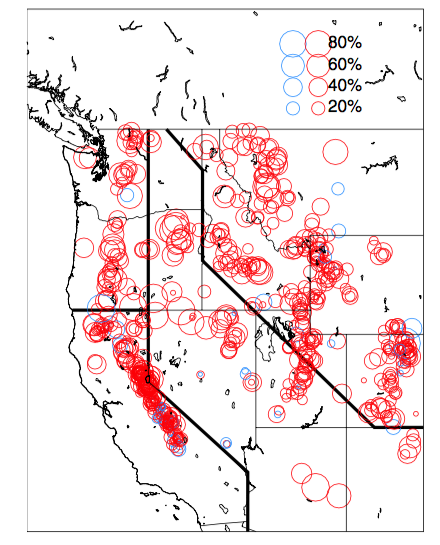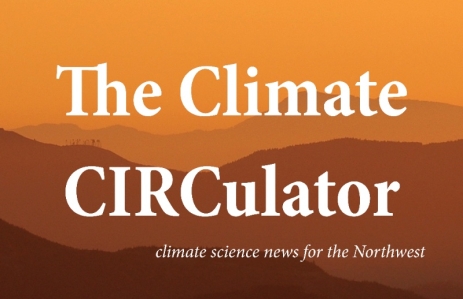Okay…it’s thought experiment time. Image that Lake Mead just disappears. Poof! America’s largest reservoir is suddenly gone.
Lake Mead hasn’t—of course—disappeared. But the equivalent of that massive marriage between the Colorado River and Hoover Dam has vanished from the American West.
This is the unsettling conclusion of a study out this month in Nature Partner Journals: Climate and Atmospheric Science with the telling title, “Dramatic declines in snowpack in the western US.” However, while dramatic, this disappearance wasn’t sudden—at least not in human terms—and the water that has disappeared isn’t liquid water per se. It’s snow.
The study, led by OCCRI Director and CIRC Co-Lead Dr. Philip Mote and including former CIRC researcher Dennis Lettenmaier and OCCRI alumna Sihan Li, examines mountain snow monitoring sites with long (more than 40 years worth of) records across the American West.
Mote and colleagues found that over 90% of these long-record sites showed declines in their snowpack over roughly the last 60 years. Using a hydrologic model to corroborate these results, the researchers concluded that this translates to the snowpack equivalent of 25 to 50 cubic kilometers of water (roughly 6–12 cubic miles). To make that really big number make sense for their readers, the researchers compare it to Lake Mead, which can hold up to 32 km3 (not quite 8 cubic miles) of water. This is a big deal.
Mountain snow—as we so often write at the CIRCulator—is super important in the American West. Mountain snow, called snowpack, acts like a natural reservoir that—in slowly melting over the summer months—provides water during the American West’s typically warm—and here in the Pacific Northwest, dry—summers. Losing this snow can lead to and exacerbate water scarcities and droughts.
But there’s more to this study than just these dramatic findings. And because we assume our readers want something extra and not just the takeaways, this blog offers up some geeky details. We’ll start by looking at three key figures from the study. Enter Figure One.
Snowpack Sites:

What you’re seeing in the figure to your left is a calculation of snowpack declines from 1955 to 2016. The calculation is based on data from in-the-field measurements of mountain snowpack taken from sites run by the U.S. Department of Agriculture’s (USDA’s) Natural Resources Conservation Service (NRCS) and the California Department of Water Resources (CADWR).
Each circle represents a site with decades of snowpack measurements. What’s being measured is snow water equivalent (SWE), or the amount of water you would get if you melted a given amount of snow. SWE in the American West is generally measured on April 1st. Years with low April 1st measures frequently see water challenges in the summers that follow.
The figure’s red circles represent decreases in SWE. Blue circles represent increases. The size of any given circle denotes by how much snow has either decreased or increased. Depending on the color, the bigger the circle the bigger the decrease or increase in SWE.
As you have probably noticed, there are significantly more red circles than blue ones on the map and a fair number of large red circles at that. In fact, 90% of the circles on this map are red. (You can count them if you’re feeling incredulous.) And—despite a few outliers—the reddening trend is region wide. What’s more, most of these red circles hover in the 40–80% range. Now let’s consider Figure Two.
Modeling with VIC:

Figure Two shows simulated snowpack declines.
As with the previous figure, reds denote decreases in SWE and blues increases. These are the results of the hydrologic model used to corroborate the in-the-field measurements.
The figure was created using the Variable Infiltration Capacity Hydrologic Model (VIC), the brainchild of CIRC researcher Dennis Lettenmaier. Using the Hamlet and Lettenmaier dataset—which employs climate data from a set of approximately 1,000 index stations from the U.S. Historical Climatology Network (USHCN)—Mote and colleagues calculated SWE for the years 1955–2014. (The year 2014 was the last year with available data at the time the study was performed.)
VIC works by running simulations that use daily precipitation and maximum and minimum temperature data as the primary variables pushing the simulation. (This is a simplified explanation. There are secondary variables derived from the primary ones and other variables, but you get the idea.)
VIC also uses elevation bands that work inside a series of grid cells. Elevation bands are pretty much what they sound like. You can think of them as a simplified version of the actual mountainous landscape of the American West, or, if you like, the West rendered video game style with less-than-perfect resolution. The effect when displayed graphically and viewed from ground level is reminiscent of a landscape that has been terraced for agriculture.
Using these temperature and precipitation data based on the USHCN dataset, Mote and colleagues used VIC to calculate SWE for roughly the same period as the in-the-field measures of snowpack mentioned above. Essentially the VIC simulations took the historic climate data—how warm it was and how much precipitation fell—and then deduced that if you had these conditions you would get such and such amounts of SWE at the different elevation bands modeled.
So why go through all this trouble running simulations if you already know from in-the-field (on-the-mountain) measurements that SWE has declined over roughly the same period? We’re glad you asked.
As you might image, measuring snow in the mountains is not easy. In-the-field sites are often put there based on their accessibility. Which makes sense. (You can’t measure what you can’t get to, and before remote sensing that was pretty much the rule.) But this also frequently means that some regions tend to be under-sampled. You need a model like VIC, therefore, to not only help corroborate your in-the-field measurements, but also as a way to deduce SWE levels at potentially under-sampled locales. To see that corroboration and how VIC helped provide a broader take on the West’s SWE losses, place Figure One and Figure Two side by side.

You’ll notice how the maps display strikingly similar increases and losses in SWE—their reds and blues landing in pretty much the same spots on both maps.
By simulating daily climate over long periods of time, VIC also allowed Mote and colleagues to essentially deconstruct those April 1st SWE measurements. Think of it this way, if any given April 1st measurement is the end to a given climate story, VIC allowed the researchers to, in a sense, work backwards from the end to determine in rough outline what led there. By doing this, Mote and colleagues were able to determine that the SWE declines that produced those low April 1st measurements were occurring during every month of year with the largest of these losses occurring during the spring months.
To put it plainly, mountain snow has been disappearing on average all year long, even during the winter months. The biggest losers have been the Pacific States, according to the researchers’ analysis. And again—not to belabor the point—the losses added up to 25–50 km3 (roughly 6–12 cubic miles) of water. Lake Mead’s carrying capacity is 32 km3 (roughly 8 cubic miles).
Climate Change and Snowpack:

However, there is another reason the researchers used VIC: they wanted to see what would happen if they removed the current warming trend caused by human-made climate change from the picture. Enter Figure Three.
Figure Three shows the results of a series of VIC runs that have taken the current warming trend out of the picture. Again the years of simulated were 1955–2014.
Figure Three—you’ve probably noticed—has a lot more blue than the previous two figures. This visually shows what’s also in the data: rising temperatures appear to be driving the loss in SWE in the American West since the middle of the last century.
Now, keep in mind that SWE levels do fluctuate from year to year. And both precipitation and temperature can play a major role in year-to-year fluctuations. However, warming over the decades is undoubtedly driving the dramatic losses over the last roughly 60 years. And if losing a full Lake Mead’s worth of snow isn’t dramatic, we’re not sure what is.
One Last Thing:
The current study looks at snowpack losses over decades, but snowpack losses from year to year can also be dramatic. As with the observed losses over the past 60 years, temperature is also driving many year-to-year losses. For more on that, here’s a quick note on a previous study.
That study—which was also led by Mote—was published in 2016 in the journal Geophysical Research Letters. The study looked at April 1st SWE in 2015. If you’ll remember, that was the worst year of the Pacific Northwest’s recent historic drought. But it wasn’t low precipitation that made that year especially droughty.
In fact, the water year of 2014/2015 saw near-normal precipitation in both Washington and Oregon. (A water year differs from the calendar year. It runs from October 1st of one calendar year to September 30th of the next.) However, the 2014/2015 water year was abnormally warm for both Washington and Oregon. (Idaho, that year is a slightly more complex story. We refer readers to Geophysical Research Letters study for more detail.) Those warm temperatures meant that what precipitation fell in Oregon and Washington tended to do so as rain and not as snow. And it wasn’t just Oregon and Washington that were hard hit, as Mote and colleagues found out.
Using methods similar to their current study, the researchers determined that 2015’s record low snowpack was widely dispersed across the American West, which for the purposes of that study included California, Oregon, Washington, Idaho, Nevada, and western Montana. As it happened, 80% of high-elevation snow measurement sites across the West showed declines in SWE. Due to their abnormally warm temperatures, Oregon and Washington were both hit especially hard. April 1st snowpack in 2015 was the lowest on record for Oregon—89% below normal—and tied for lowest on record for Washington.
As with their current study, the researchers used VIC to corroborate their findings and to see how things might have worked out had the current warming trend not been present. When VIC’s wheels stopped spinning and the results were in, the researchers concluded that human-caused climate change had added about 1° C (1.8° F) of extra warming to 2014/2015 water year, leading to water scarcities and helping exacerbate the historic drought.
![]()
Key Finding:
- Over 90% of snow monitoring sites with long records in the West show declines. The loss is calculated to be equivalent to Lake Mead.
![]()
Publication:
- Mote, Philip W., Sihan Li, Dennis P. Lettenmaier, Mu Xiao, and Ruth Engel. “Dramatic declines in snowpack in the western US.” Nature Partner Journals: Climate and Atmospheric Science volume 1, 2. (2018).
https://doi.org/10.1038/s41612-018-0012-1 .
Resources:
![]()
Pics and Figures:
- From left to right, observed April 1st Snow Water Equivalent (SWE) Trends 1955-2016. Results of VIC simulations of April 1st Snow Water Equivalent (SWE) Trends 1955–2014. Results of VIC simulations of April 1st Snow Water Equivalent (SWE) with the current warming trend removed 1955-2014. Mote et al., 2018. Image licensed under Creative Commons Attribution 4.0 International (CC BY 4.0).
 Nathan Gilles is the managing editor of The Climate Circulator, and oversees CIRC’s social media accounts and website. When he’s not writing for CIRC, Nathan works as a freelance science writer. Other Posts by this Author.
Nathan Gilles is the managing editor of The Climate Circulator, and oversees CIRC’s social media accounts and website. When he’s not writing for CIRC, Nathan works as a freelance science writer. Other Posts by this Author.

Stay up to date on the latest climate science news for the Northwest, subscribe to the CIRCulator.
